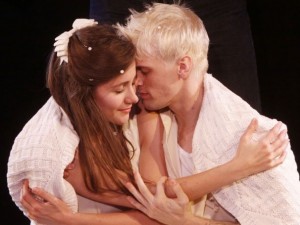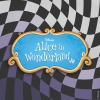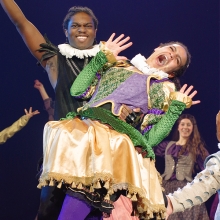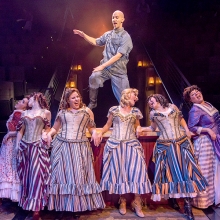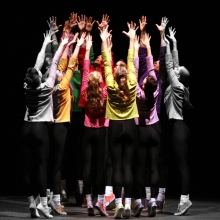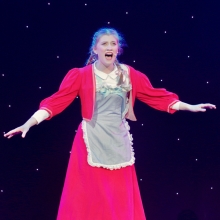Filichia Features: The Fantastic Musical
Filichia Features: The Fantastic Musical
 Sports fans mark May 3 as the day Joltin’ Joe Di Maggio (and future Mr. Marilyn Monroe) made his major league debut with the New York Yankees in 1936. Historians will tell you that May 3 was the day that Washington, D.C. became incorporated as a city.
Sports fans mark May 3 as the day Joltin’ Joe Di Maggio (and future Mr. Marilyn Monroe) made his major league debut with the New York Yankees in 1936. Historians will tell you that May 3 was the day that Washington, D.C. became incorporated as a city.
But to musical theater enthusiasts, May 3 means only one thing: the day in 1960 when The Fantasticks, with music by Harvey Schmidt and lyrics by Tom Jones, opened at the Sullivan Street Playhouse.
It stayed there until Jan. 13, 2002 – making for no less than a 500-month, 10 day run. When it closed, dozens of people who had since become grandparents hadn’t even been born when the musical had opened.
Once The Fantasticks closed, there were those who figured that New York was done with it. But others felt that there were plenty of tourists who’d come to Manhattan and would see The Fantasticks if it only weren’t downtown where no numbered streets could easily guide them to the theater. After all, if your hotel is on 47th Street and you discover that Phantom is on 44th Street, you know you’re three blocks away. But where’s this Sullivan Street? Hearing that it’s off Bleecker would be no help.
With this in mind, producers Stephen Baruch, Richard Frankel, Marc Routh and Thomas Viertel revived The Fantasticks at a brand-new theater at 50th Street and – yes – Broadway. The irony is that the most famous off-Broadway show was now genuinely on Broadway (which is more than many Broadway shows can claim).
Better still, the four producers put it in a theater that would be named for Jerry (Law & Order) Orbach -- the show’s first narrator who fancifully stepped into the action as El Gallo. Orbach was also the first to sing the show’s best-known song, the tender “Try to Remember.”
Smartly, the new theater was configured to resemble the original 153-seat Sullivan Street Playhouse, with half-circle rows surrounding the modest stage. Today’s theater economics, of course, demand more seats. But the producers didn’t overdo it. They upped the capacity from a modest three rows to a mammoth five.
To quote a lyric from the show, “‘sbeen swimming ever since.” Of the last 624 months, The Fantasticks has been in New York for more than 90% of them. This revival has racked up more than 2,300 performances – already making it the 11th longest-running show in off-Broadway history. It only has about 37 years to go before it vaults into first place and passes you-know-what.
Aaron Carter in "The Fantasticks" (Credit: Joe Marzullo)
Its plot -- based on Edmund (Cyrano de Bergerac) Rostand’s never-done Les Romanesques -- could be summarized as Boy meets Girl, Boy wants to lose Girl after they marry, Boy gets Girl and gets re-adjusted. Here, “Boy” and “Girl” are meant literally, for the characters are known as The Boy and The Girl, though they do have names: Matt and Luisa. Their fathers desperately want them to marry, so to ensure that, they pretend they hate each other and would forbid any union. Just saying “no” is enough to make the kids want to say “yes.”
Schmidt recalls what happened on that long-ago May 3. “Jean Kerr came in with her husband Walter Kerr, then the very important critic from the Herald Tribune. She sat down, tore the cover off her program, and used it to get rid of the gum she’d been chewing. What really rankled me was that that program cover had my logo on it,” he says, citing that distinctive purple lettering.
Kerr’s review and the others weren’t money notices, but producer Lore Noto was smart with money – and even smarter with ideas.
“Three of Lore’s notions turned the show into what it became,” Schmidt says. “The first one was to close the show during the height of our first summer, when business was really slow, and take it for a week to the Hamptons where all the rich people were. We begged him not to do it. We were afraid he’d use the week away as an excuse to close it forever. But he was right. Everyone out there came out to see us, and they really liked us, and spread the word.” Schmidt recalls that among the earliest supporters were Anne Bancroft, Tallulah Bankhead, Vivien Leigh and Richard Rodgers.
Noto’s second brainstorm was to allow stock companies, community theaters, and high schools to produce the show while the off-Broadway original was still running. “You never did that with secondary rights in those days,” Schmidt says. “We thought this was madness, too. But Lore said it would only whet peoples’ appetite for the New York production when they came to town. Again, he was right. Tourists really did want to check out the ‘Mother Church’ version.”
Then, in 1964, came Unorthodox Move #3. Noto allowed The Hallmark Hall of Fame to do a TV adaptation. The broadcast began with an announcer’s stating that the show was “the longest-running musical in New York.” At that point, it had run approximately 1,800 performances. Nobody knew it at the time – and few would have ever even dreamed it – but the show was only a little more than 10% into its 17,162-performance run.
John Davidson was The Boy, Susan Watson was the Girl, Ricardo Montalban was Narrator/El Gallo, Bert Lahr and Stanley Holloway were the fathers. Alas, Montalban, Lahr and Holloway are now deceased. Enough time has passed that Watson recently played a seventy-ish ex-showgirl in a Broadway revival of Follies. More to the point, Davidson is about to spend the first three weeks in June in the current off-Broadway production – as The Old Actor. Yeah, tempus does fugit.
The music is the same as it was in 1960, but the script and lyrics have undergone one profound change. Back then, the word “rape” wasn’t heard as much as it regrettably is now. In the song “It Depends on What You Pay,” Jones used it to simply mean “abduction” -- when The Girl is purposely kidnapped so that The Boy can heroically rescue her. Decades ago, Jones rewrote the lyric to accommodate the word “abduction” instead – although he retained the word “rape” in the script. It’s not said excessively, however.
Over the years, in the lucky 13 trips I’ve made to The Fantasticks, I’ve noticed that the little children in the audience – and there always are plenty -- don’t blanch at the word “rape.” What does set them giggling, however, is the word for the wealth that pirates acquire: “booty.” That’s has come to mean something very different to contemporary children.
So it’s an excellent show for children of all ages. Any theater company that’s having budgetary problems – and few aren’t – can always rely on The Fantasticks to bring in more bucks than are spent on the production. A wooden circle serves as a moon; bits of torn-up paper become snow; a wall is represented by a stick.
Granted, The Girl must hit a high C in the second-act song “Round and Round” and a few obbligatos as well, but the rest of the score isn’t vocally demanding. While the show was originally written for nine, it has long been done by eight. Finally, given that every theater company has an actor who’s such a ham that he could be stuffed with cloves, here’s a chance to use him as The Old Actor, who revels in such excesses.
Funny; The Old Actor has a line, “I’ve been dying for 40 years.” No, Old Actor: you’ve now been doing it for much longer. May you continue, along with other professional, community and school productions for 40 or more fantastic(k) years to come.
View highlights from the 50th Anniversary celebration on MTIShowSpace!
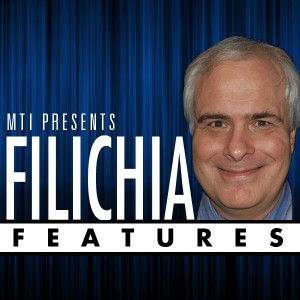 You may e-mail Peter at pfilichia@aol.com. Check out his weekly column each Tuesday at www.masterworksbroadway.com and each Friday at www.kritzerland.com and at www.mtishows.com. His newest book, Broadway Musical MVPs, 1960-2010: The Most Valuable Players of the Past 50 Seasons, is now available through Applause Books and at www.amazon.com.
You may e-mail Peter at pfilichia@aol.com. Check out his weekly column each Tuesday at www.masterworksbroadway.com and each Friday at www.kritzerland.com and at www.mtishows.com. His newest book, Broadway Musical MVPs, 1960-2010: The Most Valuable Players of the Past 50 Seasons, is now available through Applause Books and at www.amazon.com.
Share
Callboard
-
Shake and shimmy it with the #Hairspray20Challenge! Join MTI and Broadway Media in celebrating 20 years of #Hairspray. Duet this here or find us on TikTok! Special thanks to @broadwaymedia and @jammyprod. Choreography Guides are a licensor official resource that provides step-by-step instruction from Broadway and professional choreographers for your productions! Visit @broadwaymedia to learn more. #mtishows #youcantstopthebeat #hairspraymusical #goodmorningbaltimore
View on Instagram
